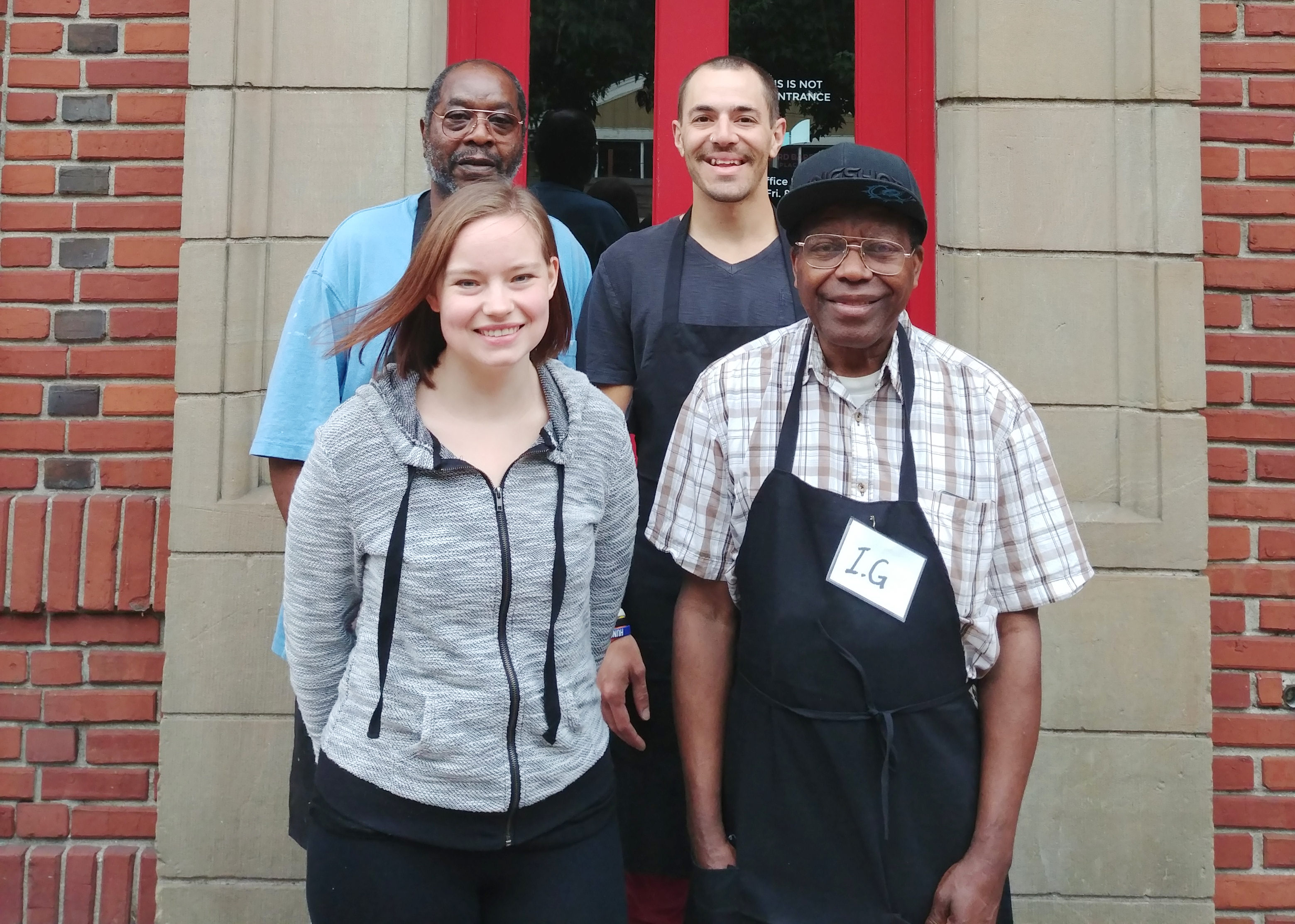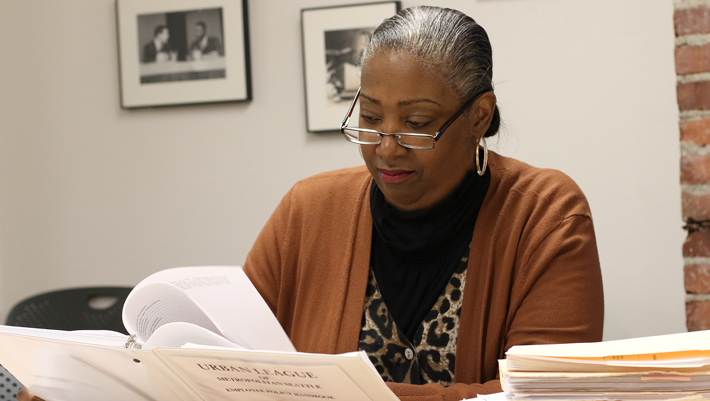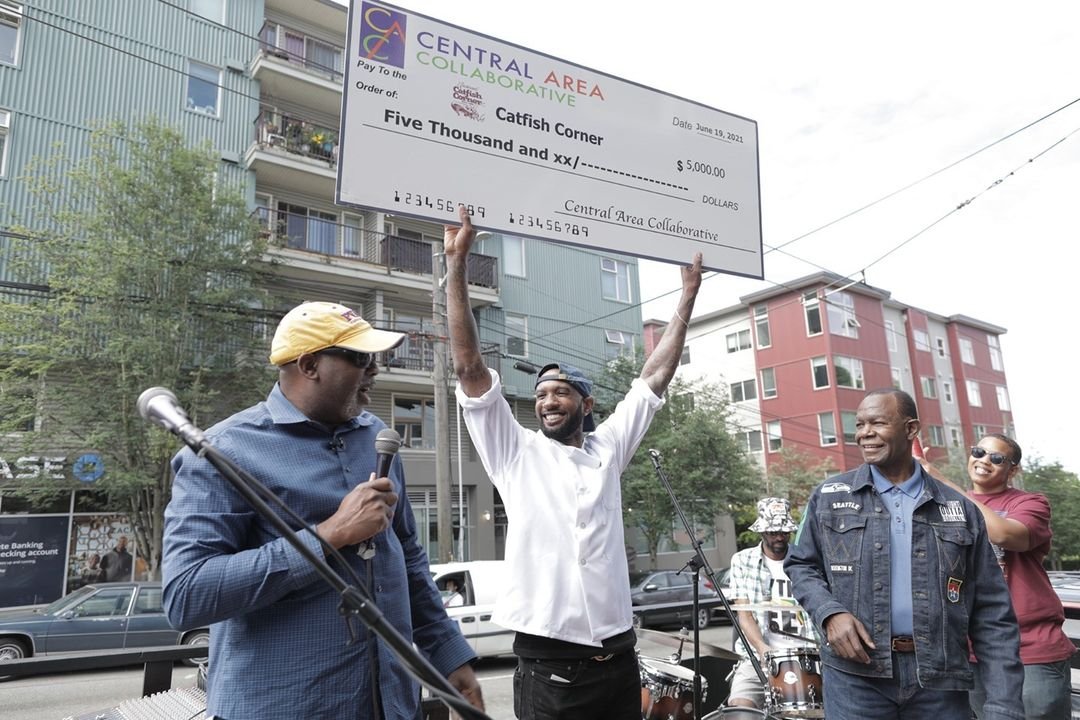 Martha Meyer (bottom left) and volunteers (clockwise from top left – Marlon, Colton, and I. G.) of Byrd Barr Place
Martha Meyer (bottom left) and volunteers (clockwise from top left – Marlon, Colton, and I. G.) of Byrd Barr Place At first glance, the challenge of providing accessible, affordable, and convenient transportation options seems outside the scope of the Seattle Department of Neighborhoods. Yet, as part of our mission to provide resources and opportunities for community members to build strong communities and improve their quality of life, we play an important part in working toward transportation equity in Seattle. By partnering with community members, local human services providers, and other City departments, we nurture meaningful relationships with underserved communities and build connections that help ensure that Seattle’s transportation options work for all residents of the city.
“Transportation equity means giving people options to choose from and letting them pick what works best for them.”
A key component to developing these relationships are people like César García García. As one of the multicultural and multilingual professionals who make up our Community Liaison program, César helps us, along with other City Departments, provide information about City services, programs, and more to Spanish-speaking residents. One of his projects was to assist with transportation equity outreach and engagement. This work involved several approaches to ensure that underserved communities were aware and took advantage of the many transportation programs available to them. Accessibility is critical, and language barriers make it harder for immigrant and refugee communities to know what transportation options are available to them. “A lot of people are unaware of the options available,” César said. “For some people, going to two or three places in a day becomes cost prohibitive and people who are eligible [for reduced fare programs] don’t always know it.”
As the Community Capacity Planning Specialist in the Seattle Department of Neighborhoods, Amy Huang understands how important it is for people to know their options. “Options give people power,” she observed. “Transportation equity means giving people options to choose from and letting them pick what works best for them.”
Communicating these options involves forming partnerships with community-based organizations and holding different types of outreach events. One approach, the Community Conversation, brings presentations from the City along with other resources to locations where underserved communities are already gathering. When holding a Community Conversation, Community Liaisons are on hand to provide interpretation and translation in different languages. By offering culturally-specific support, community members are made more comfortable and are given greater access to valuable information about available services.
“Underserved communities have been impacted by a transportation system that hasn’t worked for them. As the experts in their lives and communities, it’s important that they’re a part of the planning and decision-making process.”
Similarly, this program has been working with the Seattle Department of Transportation to organize and plan Mobility Fairs in conjunction with community-based organizations such as the Seattle Housing Authority and Literary Source. At these fairs, Community Liaisons provide interpretation and translation for attendees while sharing general information about transportation options and projects impacting their communities. “Underserved communities have been impacted by a transportation system that hasn’t worked for them. As the experts in their lives and communities, it’s important that they’re a part of the planning and decision-making process,” said Amy.
“[Immigrants] may not know that they have a voice in things like changes to bus routes or service improvements. As Community Liaisons, we’re connecting residents to the power they didn’t know they had.”
Making sure that people are aware that they have a part to play in transportation planning is critical because, according to César, “immigrants aren’t familiar with how it works in Seattle. They may not know that they have a voice in things like changes to bus routes or service improvements. As Community Liaisons, we’re connecting residents to the power they didn’t know they had.”
Last year, we re-launched the Transportation Equity Ambassador Program. This program builds partnerships with established community-based organizations that work in and with communities of color, low-income communities, and other underrepresented communities. Now, in addition to promoting and enrolling community members in King County’s ORCA-LIFT, we provided staff at People of Color Against AIDS Network (POCAAN), Entre Hermanos, Southwest Youth and Family Services, and Literacy Source with an orientation about accessible and affordable transportation options and services. Consequently, Ambassadors are equipped to discuss bike-sharing and low-income car sharing services, navigation and wayfinding tools, the Vehicle Licensing Rebate Program and more with their clients.
“The Community Liaisons have made a huge difference. They integrated smoothly into the community and felt like part of the family. Clients ask when they’ll be back.”
Another element of our outreach efforts includes working in tandem with Seattle Human Services Department’s Community Connectors at area food banks. This partnership has resulted in increased engagement with low-income and underserved communities which often include residents who have limited English proficiency.
Martha Meyer, a Community Connector at Byrd Barr Place, has worked closely with Community Liaisons to support her clients. “We have had Community Liaisons proficient in Mandarin, Cantonese, Vietnamese, and Russian here to help clients enroll in programs like ORCA-LIFT and share information about other services that are available to them. Many people take transportation for granted, but it’s not so simple for people at the lower end of the income scale,” she observed. “For people who do not have a lot of resources to exchange, what would be used for transportation can go toward other needs. The Community Liaisons have made a huge difference. They integrated smoothly into the community and felt like part of the family. Clients ask when they’ll be back.”
These interactions can also reveal new opportunities to reach additional communities. Martha recalls a Community Conversation event where this happened. “We had Community Liaisons there who spoke Cantonese. After a while, Amy realized that some of the people weren’t speaking Cantonese, but Toisanese. She helped us identify a language we hadn’t realized was necessary.”
Overall, our Community Liaison program is guided by the Seattle Department of Neighborhood’s principle of meeting people where they are. This results in greater participation because, among other things, it eliminates the need for residents to make special arrangements — whether securing child care, taking time off work, or coordinating transportation — to attend events. Yet, Community Liaisons do more than just communicate information to residents while at events; they provide an opportunity for community members to share their insights with the City. “We hear comments from residents and share this with the City government,” explained César. “Information goes both ways. Community Liaisons are that connector.”
While discussions about transportation often focus on “how” and “where,” the Seattle Department of Neighborhoods helps center the “who” by developing relationships with communities throughout Seattle. Through the work of people like César and partnerships with community-based organizations, we help keep the city moving toward a more equitable future.


